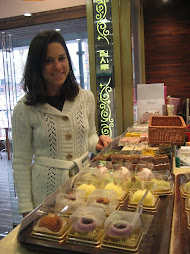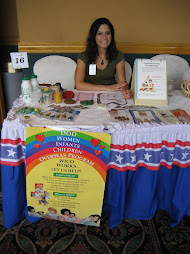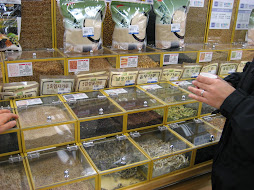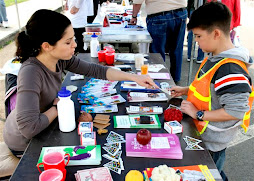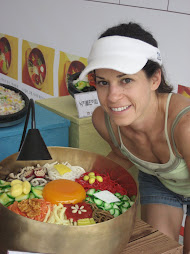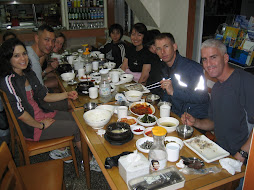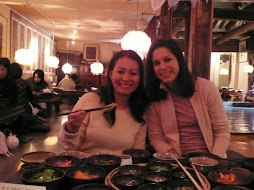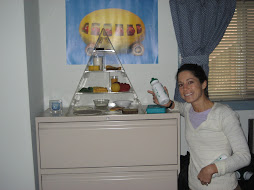Monday, January 26, 2009
Ddeokguk Soup for Seollal
Lunar new year or Seollal is on January 26 this year. Koreans visit family, wear hanbok, see the first rays of sunrise, give gifts to kids, show respect for parents, and eat ddeokguk soup. No one works today, and Korean employees don't even work tomorrow!
 We decided to try ddeokguk soup, a mixture of seasonings, rice cakes, and mandu. My friend prepared two versions, a rich, pork mandu for the guys, and a light, kimchi mandu for the ladies.
We decided to try ddeokguk soup, a mixture of seasonings, rice cakes, and mandu. My friend prepared two versions, a rich, pork mandu for the guys, and a light, kimchi mandu for the ladies.
 We decided to try ddeokguk soup, a mixture of seasonings, rice cakes, and mandu. My friend prepared two versions, a rich, pork mandu for the guys, and a light, kimchi mandu for the ladies.
We decided to try ddeokguk soup, a mixture of seasonings, rice cakes, and mandu. My friend prepared two versions, a rich, pork mandu for the guys, and a light, kimchi mandu for the ladies. She topped the soup with egg white or yolk strips and dried seaweed:
 The snowy weather was perfect for hot soup:
The snowy weather was perfect for hot soup: Everyone is one year older upon eating the soup. The soup also provides good luck.
Everyone is one year older upon eating the soup. The soup also provides good luck.
 The soup was absolutely delicious! The mandu was so tender, and the broth was flavorful.
The soup was absolutely delicious! The mandu was so tender, and the broth was flavorful.
 The snowy weather was perfect for hot soup:
The snowy weather was perfect for hot soup: Everyone is one year older upon eating the soup. The soup also provides good luck.
Everyone is one year older upon eating the soup. The soup also provides good luck. The soup was absolutely delicious! The mandu was so tender, and the broth was flavorful.
The soup was absolutely delicious! The mandu was so tender, and the broth was flavorful. Our hostess purchased the side dishes (and mandu) from a local vendor. They included fish, meat, and seasoned spinach, bracken, sprouts, and an unidentifiable vegetable. The wife of our host's boss provided the kimchi'i. She prepares 100 cabbage heads worth of kimchi'i each year! Talk about spicy.
Happy New Year!
Sunday, January 25, 2009
Starbucks Saturdays
I study for my personal trainer certification almost every Saturday at Starbucks. Usually I meet my study friend at the "Itaewon West" location.
In 2001 during my first stay in Korea, cafes were rare. This time however, a new one seems to open every week. In fact, two Starbucks have opened in Itaewon since my arrival in 2007, making a grand total of three!
Post already has two locations of its own. The on-post locations feel American. The off-post ones have Korean touches: green tea scones, no sugar free options, liquid sugar. The Korean ambiance is there: noisy, crowded, hot, and multi-storied. The smokers have their own section, a glass enclosed area with the best view and the most natural light. To use the free internet, one must have a Korean identification number. The Korean Starbucks also have recycling bins for lids, cups, liquids, and everything else: This weekend Eric made a surprise visit:
This weekend Eric made a surprise visit: And promptly feel asleep in his chair!
And promptly feel asleep in his chair!
In 2001 during my first stay in Korea, cafes were rare. This time however, a new one seems to open every week. In fact, two Starbucks have opened in Itaewon since my arrival in 2007, making a grand total of three!
Post already has two locations of its own. The on-post locations feel American. The off-post ones have Korean touches: green tea scones, no sugar free options, liquid sugar. The Korean ambiance is there: noisy, crowded, hot, and multi-storied. The smokers have their own section, a glass enclosed area with the best view and the most natural light. To use the free internet, one must have a Korean identification number. The Korean Starbucks also have recycling bins for lids, cups, liquids, and everything else:
 This weekend Eric made a surprise visit:
This weekend Eric made a surprise visit: And promptly feel asleep in his chair!
And promptly feel asleep in his chair!
Tuesday, January 20, 2009
The Fruit Man Near Yongsan Station
Tteok Cafe Jilsiru
We had to try the rice cakes after visiting the museum. Each rice cake cost 1500W or about $1.10. So many choices!  We drank persimmon leaf tea rich in vitamin C:
We drank persimmon leaf tea rich in vitamin C: The tea was disappointing. I could have prepared a cup at home with a leaf cutting!
The tea was disappointing. I could have prepared a cup at home with a leaf cutting! Potted herbs and lit, scented candles sat on each table. The place was quiet, even relaxing, a rarity for a Korean cafe.
Potted herbs and lit, scented candles sat on each table. The place was quiet, even relaxing, a rarity for a Korean cafe. Our plate of rice cakes (from left to right) included dense black bean, dense pumpkin and seeds, green tea round, and citron acorn. The citron rice cake, our favorite, tasted like a fresh orange. I loved how the rice cakes were halved despite their small size.
Our plate of rice cakes (from left to right) included dense black bean, dense pumpkin and seeds, green tea round, and citron acorn. The citron rice cake, our favorite, tasted like a fresh orange. I loved how the rice cakes were halved despite their small size. A sweet, green tea paste filled the green ball.
A sweet, green tea paste filled the green ball.  I swear the powder is ground black bean and not dirt!
I swear the powder is ground black bean and not dirt!
Would rice cakes have a place in America's 'Starbucked' culture?
 We drank persimmon leaf tea rich in vitamin C:
We drank persimmon leaf tea rich in vitamin C: The tea was disappointing. I could have prepared a cup at home with a leaf cutting!
The tea was disappointing. I could have prepared a cup at home with a leaf cutting! Potted herbs and lit, scented candles sat on each table. The place was quiet, even relaxing, a rarity for a Korean cafe.
Potted herbs and lit, scented candles sat on each table. The place was quiet, even relaxing, a rarity for a Korean cafe. Our plate of rice cakes (from left to right) included dense black bean, dense pumpkin and seeds, green tea round, and citron acorn. The citron rice cake, our favorite, tasted like a fresh orange. I loved how the rice cakes were halved despite their small size.
Our plate of rice cakes (from left to right) included dense black bean, dense pumpkin and seeds, green tea round, and citron acorn. The citron rice cake, our favorite, tasted like a fresh orange. I loved how the rice cakes were halved despite their small size. A sweet, green tea paste filled the green ball.
A sweet, green tea paste filled the green ball.  I swear the powder is ground black bean and not dirt!
I swear the powder is ground black bean and not dirt!Would rice cakes have a place in America's 'Starbucked' culture?
Monday, January 19, 2009
Tteok Musem in Insa-dong
Since I enjoy Korean rice cakes so much, I decided to visit the Tteok Museum.  The Institute of Korean Food has exhibits on two floors. We considered taking the school's cooking classes, but I don't envision myself making time-consuming foods like tteok.
The Institute of Korean Food has exhibits on two floors. We considered taking the school's cooking classes, but I don't envision myself making time-consuming foods like tteok. The first floor displayed utensils used to prepare rice cakes. Some of these tools were commonplace in kitchens as recently as 20 years ago!
The first floor displayed utensils used to prepare rice cakes. Some of these tools were commonplace in kitchens as recently as 20 years ago!
One version of rice cake involves pounding the steamed rice in a mortar: Other methods of preparation include steaming, frying, and boiling. Rice cakes were never baked since Koreans lacked ovens. The rice blobs are formed into different shapes. Round, flat, and acorn shapes are common. An imprint or decoration might be pressed on the flattened surface. The rice cake below is the same size as a standard birthday cake!
Other methods of preparation include steaming, frying, and boiling. Rice cakes were never baked since Koreans lacked ovens. The rice blobs are formed into different shapes. Round, flat, and acorn shapes are common. An imprint or decoration might be pressed on the flattened surface. The rice cake below is the same size as a standard birthday cake! As the name suggests, rice is the primary ingredient, but other grains may also be used. The cake often has a flavored center or mix-ins, including beans, nuts, fruits, vegetables, flowers, dye and herbs. Rice cakes are usually mildly sweet, but may also be part of a savory soup. The texture is gummy and sticky, somewhere between gnochi and a marshmellow. Some rice cakes are denser than others.
As the name suggests, rice is the primary ingredient, but other grains may also be used. The cake often has a flavored center or mix-ins, including beans, nuts, fruits, vegetables, flowers, dye and herbs. Rice cakes are usually mildly sweet, but may also be part of a savory soup. The texture is gummy and sticky, somewhere between gnochi and a marshmellow. Some rice cakes are denser than others.  Historically, only aristocrats could afford rice cakes. As tools advanced, commoners also began to eat them. Rice cakes became an important part of ceremonies and holidays. For example, children throw a large party to honor a parent's hoegamnye or 60th birthday. They must set a sumptuous table of food called mansang, which means "a table to gaze at." I did not believe it until I saw a historical picture of mansang. Wouldn't it be too tempting to pull a cake from the center row?
Historically, only aristocrats could afford rice cakes. As tools advanced, commoners also began to eat them. Rice cakes became an important part of ceremonies and holidays. For example, children throw a large party to honor a parent's hoegamnye or 60th birthday. They must set a sumptuous table of food called mansang, which means "a table to gaze at." I did not believe it until I saw a historical picture of mansang. Wouldn't it be too tempting to pull a cake from the center row? Another important ceremony is ancestor worhip. Living family members offer foods or other items, called jesu, based on custom and finances. The offerings may be made at the burial site or elsewhere.
Another important ceremony is ancestor worhip. Living family members offer foods or other items, called jesu, based on custom and finances. The offerings may be made at the burial site or elsewhere. 
A specific rice cake is associated with each season and most holidays. Instead of listing them here, I will post about them as time passes. With Lunar New Year on January 26, 2009, you can expect a post soon!
 The Institute of Korean Food has exhibits on two floors. We considered taking the school's cooking classes, but I don't envision myself making time-consuming foods like tteok.
The Institute of Korean Food has exhibits on two floors. We considered taking the school's cooking classes, but I don't envision myself making time-consuming foods like tteok. The first floor displayed utensils used to prepare rice cakes. Some of these tools were commonplace in kitchens as recently as 20 years ago!
The first floor displayed utensils used to prepare rice cakes. Some of these tools were commonplace in kitchens as recently as 20 years ago!One version of rice cake involves pounding the steamed rice in a mortar:
 Other methods of preparation include steaming, frying, and boiling. Rice cakes were never baked since Koreans lacked ovens. The rice blobs are formed into different shapes. Round, flat, and acorn shapes are common. An imprint or decoration might be pressed on the flattened surface. The rice cake below is the same size as a standard birthday cake!
Other methods of preparation include steaming, frying, and boiling. Rice cakes were never baked since Koreans lacked ovens. The rice blobs are formed into different shapes. Round, flat, and acorn shapes are common. An imprint or decoration might be pressed on the flattened surface. The rice cake below is the same size as a standard birthday cake! As the name suggests, rice is the primary ingredient, but other grains may also be used. The cake often has a flavored center or mix-ins, including beans, nuts, fruits, vegetables, flowers, dye and herbs. Rice cakes are usually mildly sweet, but may also be part of a savory soup. The texture is gummy and sticky, somewhere between gnochi and a marshmellow. Some rice cakes are denser than others.
As the name suggests, rice is the primary ingredient, but other grains may also be used. The cake often has a flavored center or mix-ins, including beans, nuts, fruits, vegetables, flowers, dye and herbs. Rice cakes are usually mildly sweet, but may also be part of a savory soup. The texture is gummy and sticky, somewhere between gnochi and a marshmellow. Some rice cakes are denser than others.  Historically, only aristocrats could afford rice cakes. As tools advanced, commoners also began to eat them. Rice cakes became an important part of ceremonies and holidays. For example, children throw a large party to honor a parent's hoegamnye or 60th birthday. They must set a sumptuous table of food called mansang, which means "a table to gaze at." I did not believe it until I saw a historical picture of mansang. Wouldn't it be too tempting to pull a cake from the center row?
Historically, only aristocrats could afford rice cakes. As tools advanced, commoners also began to eat them. Rice cakes became an important part of ceremonies and holidays. For example, children throw a large party to honor a parent's hoegamnye or 60th birthday. They must set a sumptuous table of food called mansang, which means "a table to gaze at." I did not believe it until I saw a historical picture of mansang. Wouldn't it be too tempting to pull a cake from the center row? Another important ceremony is ancestor worhip. Living family members offer foods or other items, called jesu, based on custom and finances. The offerings may be made at the burial site or elsewhere.
Another important ceremony is ancestor worhip. Living family members offer foods or other items, called jesu, based on custom and finances. The offerings may be made at the burial site or elsewhere. 
A specific rice cake is associated with each season and most holidays. Instead of listing them here, I will post about them as time passes. With Lunar New Year on January 26, 2009, you can expect a post soon!
Saturday, January 17, 2009
"Knife Noodles" in Myeongdong
After several hours of shopping in Dongdaemun's shoe alley, we headed to a famous noodle place in Myeongdong: The menu had three items: a spicy noodle dish, a noodle soup, and pork dumplings. According to my friend, who watched a TV program about this restaurant, the noodles require careful preparation. The cook must pull the dough into long strands, bend it in half, and pull again. Eventually, the dough might be stretched into 100 strands! Then the cook cuts the long strands into edible pieces with a knife.
The menu had three items: a spicy noodle dish, a noodle soup, and pork dumplings. According to my friend, who watched a TV program about this restaurant, the noodles require careful preparation. The cook must pull the dough into long strands, bend it in half, and pull again. Eventually, the dough might be stretched into 100 strands! Then the cook cuts the long strands into edible pieces with a knife.
The noodles are aptly called kalguksu or "knife noodles":
 The hostess directed patrons to an upstairs or downstairs line. I've noticed that all places with a "as seen on KBS televison" sign have monstrous lines. Fortunately, we arrived before the dinner crowd:
The hostess directed patrons to an upstairs or downstairs line. I've noticed that all places with a "as seen on KBS televison" sign have monstrous lines. Fortunately, we arrived before the dinner crowd: They had quite a system going to keep the line moving. We ordered and paid upon being seated. Within minutes, this plate of steamed pork buns landed on our table:
They had quite a system going to keep the line moving. We ordered and paid upon being seated. Within minutes, this plate of steamed pork buns landed on our table: The sole pork-eater in our group ate the entire plate! Too bad, because he was full by the time our kalgaksu arrived:
The sole pork-eater in our group ate the entire plate! Too bad, because he was full by the time our kalgaksu arrived:
 We ordered our noodles without ground beef. My friend spooned out a small portion for me. She instructed to eat the noodles first and then add rice to eat the broth. (Can I have some protein with that starch???):
We ordered our noodles without ground beef. My friend spooned out a small portion for me. She instructed to eat the noodles first and then add rice to eat the broth. (Can I have some protein with that starch???): I don't care for most pastas, but these tender noodles were delicious! The broth was mildly spicy and deeply flavored. In retrospect, I wouldn't be surprised if MSG or one of its disguised relatives was a prime ingredient. Not only did I have soup-breath until the following morning, but I also had swollen lymph nodes and fatigue. (Please don't think I'm overreacting!)
I don't care for most pastas, but these tender noodles were delicious! The broth was mildly spicy and deeply flavored. In retrospect, I wouldn't be surprised if MSG or one of its disguised relatives was a prime ingredient. Not only did I have soup-breath until the following morning, but I also had swollen lymph nodes and fatigue. (Please don't think I'm overreacting!)
After this meal, I could understand ice cream's popularity in Korea!
 The menu had three items: a spicy noodle dish, a noodle soup, and pork dumplings. According to my friend, who watched a TV program about this restaurant, the noodles require careful preparation. The cook must pull the dough into long strands, bend it in half, and pull again. Eventually, the dough might be stretched into 100 strands! Then the cook cuts the long strands into edible pieces with a knife.
The menu had three items: a spicy noodle dish, a noodle soup, and pork dumplings. According to my friend, who watched a TV program about this restaurant, the noodles require careful preparation. The cook must pull the dough into long strands, bend it in half, and pull again. Eventually, the dough might be stretched into 100 strands! Then the cook cuts the long strands into edible pieces with a knife.The noodles are aptly called kalguksu or "knife noodles":
 The hostess directed patrons to an upstairs or downstairs line. I've noticed that all places with a "as seen on KBS televison" sign have monstrous lines. Fortunately, we arrived before the dinner crowd:
The hostess directed patrons to an upstairs or downstairs line. I've noticed that all places with a "as seen on KBS televison" sign have monstrous lines. Fortunately, we arrived before the dinner crowd: They had quite a system going to keep the line moving. We ordered and paid upon being seated. Within minutes, this plate of steamed pork buns landed on our table:
They had quite a system going to keep the line moving. We ordered and paid upon being seated. Within minutes, this plate of steamed pork buns landed on our table: The sole pork-eater in our group ate the entire plate! Too bad, because he was full by the time our kalgaksu arrived:
The sole pork-eater in our group ate the entire plate! Too bad, because he was full by the time our kalgaksu arrived: We ordered our noodles without ground beef. My friend spooned out a small portion for me. She instructed to eat the noodles first and then add rice to eat the broth. (Can I have some protein with that starch???):
We ordered our noodles without ground beef. My friend spooned out a small portion for me. She instructed to eat the noodles first and then add rice to eat the broth. (Can I have some protein with that starch???): I don't care for most pastas, but these tender noodles were delicious! The broth was mildly spicy and deeply flavored. In retrospect, I wouldn't be surprised if MSG or one of its disguised relatives was a prime ingredient. Not only did I have soup-breath until the following morning, but I also had swollen lymph nodes and fatigue. (Please don't think I'm overreacting!)
I don't care for most pastas, but these tender noodles were delicious! The broth was mildly spicy and deeply flavored. In retrospect, I wouldn't be surprised if MSG or one of its disguised relatives was a prime ingredient. Not only did I have soup-breath until the following morning, but I also had swollen lymph nodes and fatigue. (Please don't think I'm overreacting!)Anyway, this red papper sauce was the dish's approved condiment:
After this meal, I could understand ice cream's popularity in Korea!
Tuesday, January 6, 2009
Green Buns in Dongdaemun
Most of the shops in Dongdaemun were closed over New Year's weekend, but I still managed to buy something new:
 The bun was hot, filling, and well worth the 1000 won. The texture of the green-dyed bread resembled that of damp bread with big air holes. The red bean provided most of the flavor.
The bun was hot, filling, and well worth the 1000 won. The texture of the green-dyed bread resembled that of damp bread with big air holes. The red bean provided most of the flavor.
 The bun was hot, filling, and well worth the 1000 won. The texture of the green-dyed bread resembled that of damp bread with big air holes. The red bean provided most of the flavor.
The bun was hot, filling, and well worth the 1000 won. The texture of the green-dyed bread resembled that of damp bread with big air holes. The red bean provided most of the flavor.Sunday, January 4, 2009
Hot Porridge on a Cold Day in Bundang
Eric and I spend Sunday afternoons together. We take turns planning an activity. This past weekend we visited an upscale neighborhood that he discovered when cycling. The street was quiet, not crowded, tree-lined, organized, and clean: We stopped at Bon Juk for a snack. The sign advertised black bean juk because Koreans traditionally eat this porridge one day in December.
We stopped at Bon Juk for a snack. The sign advertised black bean juk because Koreans traditionally eat this porridge one day in December.
At least unfaithful spouses and unwed young people need not travel far from home!
 We stopped at Bon Juk for a snack. The sign advertised black bean juk because Koreans traditionally eat this porridge one day in December.
We stopped at Bon Juk for a snack. The sign advertised black bean juk because Koreans traditionally eat this porridge one day in December.At least unfaithful spouses and unwed young people need not travel far from home!
Subscribe to:
Comments (Atom)

















